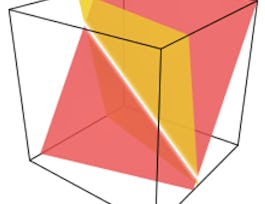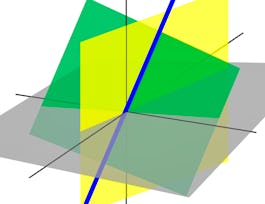Linear algebra and calculus are the two most important foundational pillars on which modern mathematics is built. They are studied by almost all mathematics students at university, though typically labelled as different subjects and taught in parallel. Over time, students discover that linear algebra and calculus are inseparable (but not identical) twins that interlock to form the backbone of almost all applications of mathematics to physical and biological sciences, engineering and computer science. It is recommended that participants in the MOOC Introduction to Linear Algebra have already taken, or take in parallel, the MOOC Introduction to Calculus.



Introduction to Linear Algebra

Instructor: David Easdown
Top Instructor
Sponsored by BIDAcademy
5,720 already enrolled
(24 reviews)
Details to know

Add to your LinkedIn profile
28 assignments
See how employees at top companies are mastering in-demand skills


Earn a career certificate
Add this credential to your LinkedIn profile, resume, or CV
Share it on social media and in your performance review

There are 4 modules in this course
This module introduces and explores the useful and elegant arithmetic of geometric vectors, regarded as directed line segments, which move about freely in the plane and in space. Objects in this arithmetic are ubiquitous throughout the physical world, modelling vector quantities. Students acquire tools that enable them to explore precise geometrical relationships between objects, prove difficult theorems and solve optimisation problems. This arithmetic forms a prototype for the general and abstract theory of vector spaces, developing students’ intuition and preparing them for advanced courses on linear algebra.
What's included
10 videos11 readings10 assignments
This module introduces and develops fluency with lines and planes in space, represented by vector and Cartesian equations. Students learn how to exploit the arithmetic of geometric vectors to solve difficult optimisation problems such as finding the closest point to a plane or finding the closest points on a pair of skew lines. The module introduces systems of linear equations and then develops the method of Gaussian elimination, using elementary row operations, followed by back substitution, to express solutions in terms of parameters. Systems of equations are also explored and solved using modular arithmetic with respect to a given prime number.
What's included
8 videos6 readings7 assignments
This module introduces matrix arithmetic and the theory of determinants. Students first learn how to add matrices of the same size and how to multiply by a scalar. They then learn how to multiply matrices of compatible sizes, using cascades of dot products of rows with columns. This is described succinctly using Sigma notation, which is then used to prove associativity of matrix multiplication. Students learn about elementary matrices, which are basic building blocks in matrix arithmetic, closely related to elementary row operations used in Gaussian elimination. Students learn about matrix inverses and how to find them. Students learn about determinants and their properties, including the multiplicative property and a simple criterion for recognising invertibility of a matrix. Students see applications to cross products of vectors and for exploring spatial relationships between points and triangles.
What's included
11 videos5 readings5 assignments
This module continues the development of matrix arithmetic by introducing eigenvalues and associated eigenvectors. Interpreted geometrically, these allow one to find directions in which a given linear operator associated with a matrix moves vectors in straight lines. This leads to the technique of diagonalisation, enabling one to solve difficult problems in matrix arithmetic, including finding formulae for powers of a given square matrix. This has many applications, including, for example, in exploring the behaviour of a Markov process described by a stochastic matrix, the mathematics of which underlies search engines on the internet. Eigenvalues can be found, in principle, by solving the characteristic equation of a matrix. Associated eigenvectors can then be found by solving an associated homogeneous system of equations. In practice, there are iterative numerical techniques for finding approximations of eigenvalues and eigenvectors, using a technique associated with Perron’s Theorem. Diagonalisation is a manifestation of the general Conjugation Principle, explored in different contexts. Linear transformations are introduced, focusing on transformation of the plane. Rotations and reflections of the plane combine to form the two-dimensional orthogonal group. Scalar dilations and rotations combine to form a copy of the field of complex numbers. A sketch of Smale’s proof of the Fundamental Theorem of Algebra is given, which says that any nonconstant polynomial with complex coefficients has a complex root, so that all square matrices have eigenvalues, when working over the field of complex numbers.
What's included
13 videos6 readings6 assignments
Instructor

Offered by
Why people choose Coursera for their career




Learner reviews
24 reviews
- 5 stars
83.33%
- 4 stars
16.66%
- 3 stars
0%
- 2 stars
0%
- 1 star
0%
Showing 3 of 24
Reviewed on Jan 7, 2024
Intro concepts for linear algebra taught well, but I found the modular arithmetic topics out of place for something like an intro course. The last section has applications too which is nice.
Reviewed on May 18, 2024
Grazie mille per questo corso bellissimo. Grazie al professore! Thank you very much for this beautiful course!
Reviewed on Jul 6, 2024
Thank you Professor Easdown. Look forward to more math courses from you
Recommended if you're interested in Math and Logic

Johns Hopkins University

Johns Hopkins University

Howard University

Johns Hopkins University

Open new doors with Coursera Plus
Unlimited access to 10,000+ world-class courses, hands-on projects, and job-ready certificate programs - all included in your subscription
Advance your career with an online degree
Earn a degree from world-class universities - 100% online
Join over 3,400 global companies that choose Coursera for Business
Upskill your employees to excel in the digital economy


